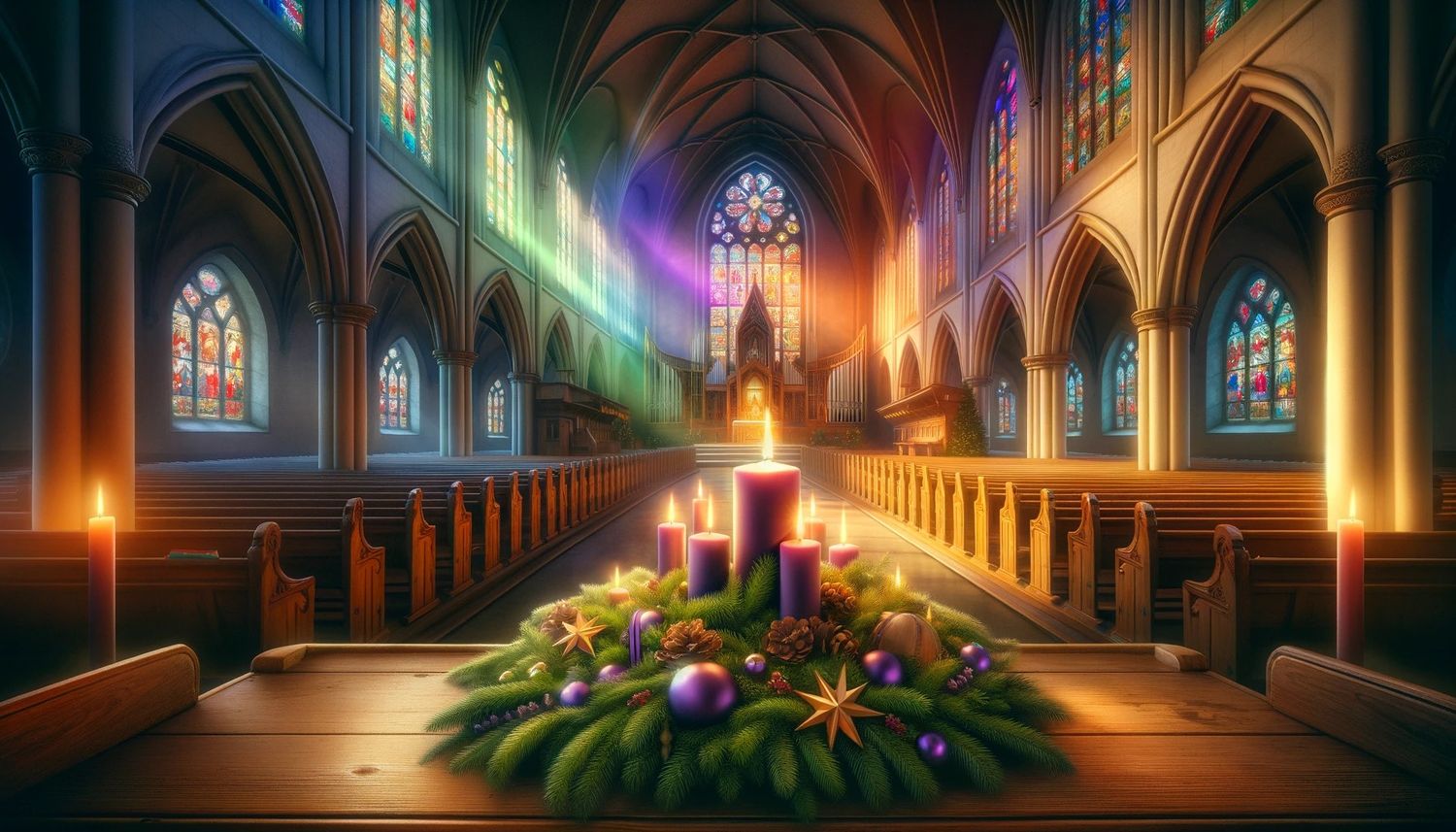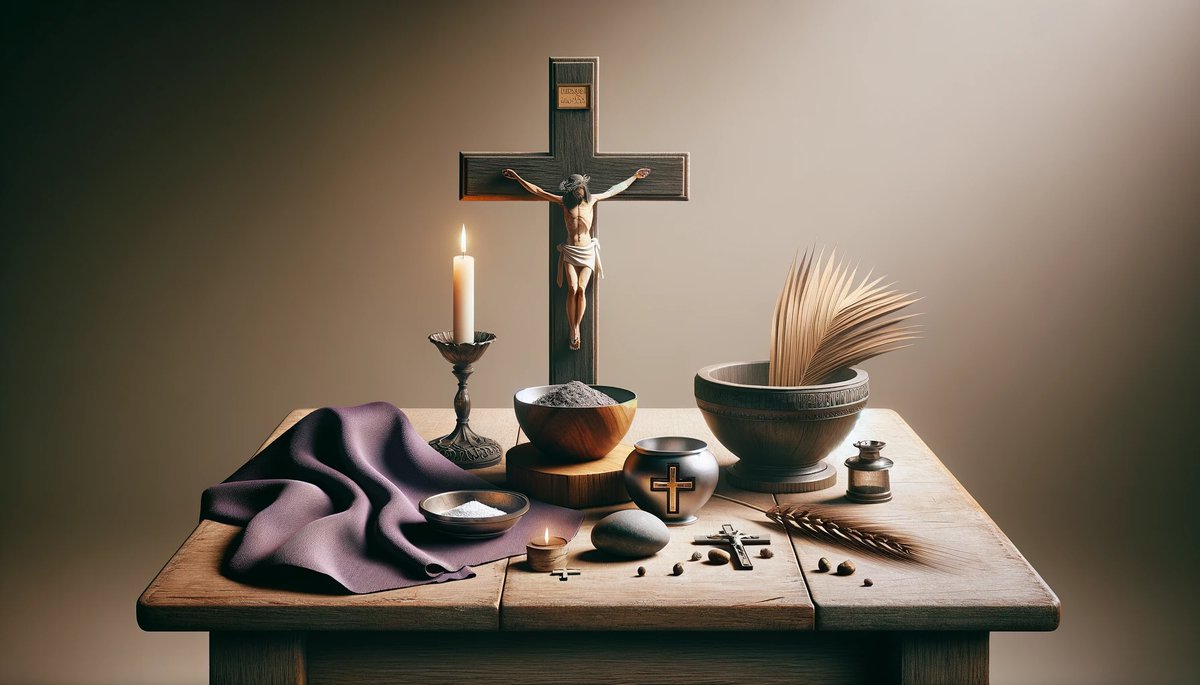Home>Special Themes>What Is The Symbol Of Advent?


Special Themes
What Is The Symbol Of Advent?
Published: February 14, 2024
Ericka Andersen, an editor at Christian.net, expertly merges digital strategy with content creation, focusing on faith and societal issues. Her communication skills enhance the platform's engaging narratives, fostering meaningful dialogue on belief's impact on society.
Discover the significance of the Advent symbol and its role in special themes. Uncover the rich history and meaning behind this cherished tradition.
(Many of the links in this article redirect to a specific reviewed product. Your purchase of these products through affiliate links helps to generate commission for Christian.net, at no extra cost. Learn more)
Table of Contents
Introduction
Advent, a word derived from the Latin "adventus," meaning "coming" or "arrival," marks the beginning of the liturgical year in the Christian calendar. It is a season of anticipation, preparation, and hope as believers await the celebration of the birth of Jesus Christ. The observance of Advent typically spans the four Sundays leading up to Christmas, serving as a time of spiritual reflection and joyful expectation.
During this period, Christians worldwide engage in various traditions and rituals that symbolize the anticipation of the birth of Jesus. One of the most recognizable symbols of Advent is the Advent wreath, which holds deep significance and serves as a focal point in many homes and churches. The lighting of the Advent candles on the wreath represents the increasing brightness and hope as Christmas draws near.
As we delve into the history, meaning, and symbolism of the Advent wreath and other significant symbols associated with this sacred season, we will gain a deeper understanding of the rich traditions and spiritual significance that characterize the observance of Advent. Let us embark on a journey to explore the profound symbolism and timeless traditions that have been cherished by generations of faithful believers.
Read more: What Are The Symbols Of Advent Wreath
History of Advent
The history of Advent can be traced back to the early centuries of Christianity. While the exact origins of Advent are not definitively documented, its roots can be found in the practices of early Christians who sought to prepare for the celebration of the birth of Jesus Christ. The concept of a preparatory period before Christmas began to take shape in the fourth and fifth centuries, with the focus on spiritual reflection, repentance, and anticipation of the coming of Christ.
During this formative period, Advent was observed as a time of fasting and penance, akin to the solemnity of Lent. It was a season of spiritual preparation, not only for the commemoration of Christ's birth but also for the anticipation of His second coming. The early Christians viewed Advent as a time to reflect on the significance of the Incarnation and to prepare their hearts to welcome the Savior.
Over time, the observance of Advent evolved, incorporating various traditions and customs from different regions and denominations within the Christian faith. The length of Advent has also undergone changes, with some traditions observing a period of fasting and abstinence throughout its duration, while others focus on the spiritual themes of hope, peace, joy, and love during the four weeks leading up to Christmas.
The liturgical aspects of Advent, including the use of Advent wreaths, the lighting of candles, and the reading of specific biblical passages, became more prominent in the Middle Ages. These practices were designed to guide believers through a period of spiritual preparation and reflection, emphasizing the themes of anticipation and longing for the coming of Christ.
In the modern era, Advent continues to hold a significant place in the hearts of believers, serving as a time of spiritual renewal and joyful expectation. The observance of Advent has expanded beyond traditional church settings, with many families incorporating Advent wreaths and candles into their homes, creating a sacred space for reflection and prayer during the Christmas season.
As we reflect on the history of Advent, we recognize the enduring legacy of this sacred season, which has evolved over centuries while retaining its core emphasis on spiritual preparation, anticipation, and the celebration of the birth of Jesus Christ.
The Meaning of the Advent Wreath
The Advent wreath is a powerful symbol that encapsulates the essence of the Advent season. Its circular shape represents eternity and the unending nature of God's love and the promise of eternal life. The evergreen foliage used in the wreath symbolizes hope and renewal, reflecting the everlasting life found in Christ. The wreath's vibrant greenery also serves as a reminder of the continuous growth and vitality of faith, even in the midst of winter's dormancy.
The wreath typically features four candles, each representing one of the four Sundays of Advent. Three of these candles are purple, symbolizing penitence, preparation, and royalty, while the fourth candle, often lit on the third Sunday of Advent, is pink or rose-colored, signifying joy and rejoicing as the anticipation of Christ's birth intensifies.
Additionally, some Advent wreaths include a fifth candle, known as the Christ candle, positioned at the center of the wreath. This candle is white, symbolizing purity and the light of Christ. It is traditionally lit on Christmas Eve or Christmas Day, representing the culmination of the Advent season and the birth of Jesus, the Light of the World.
The lighting of the Advent candles, one for each week of Advent, serves as a visual representation of the increasing brightness and hope as Christmas draws near. The progression from the first candle to the fourth, and ultimately to the Christ candle, mirrors the spiritual journey of believers as they move from anticipation and preparation to the joyous celebration of the birth of Christ.
Beyond its visual symbolism, the Advent wreath holds a profound spiritual significance. It serves as a focal point for prayer, reflection, and meditation during the Advent season, providing a sacred space for individuals and families to come together and contemplate the deeper meaning of Christ's coming into the world. The act of lighting the candles each week fosters a sense of anticipation and spiritual preparation, guiding believers through the themes of hope, peace, joy, and love that characterize the Advent season.
In homes and churches around the world, the Advent wreath stands as a timeless symbol of faith, unity, and the enduring promise of God's love. It invites believers to pause, reflect, and embrace the profound significance of Christ's birth, fostering a spirit of reverence and joyful expectation as the Christmas season approaches.
The Symbolism of the Advent Wreath
The Advent wreath, with its rich symbolism and profound significance, serves as a powerful visual representation of the themes and anticipation of the Advent season. Each element of the wreath carries deep meaning, weaving together a tapestry of spiritual truths and timeless traditions.
The circular shape of the Advent wreath holds profound symbolism, representing eternity and the unending nature of God's love. It serves as a reminder of the eternal life found in Christ and the promise of everlasting hope. The evergreen foliage adorning the wreath further reinforces this symbolism, signifying renewal, vitality, and the enduring nature of faith. Amidst the winter's dormancy, the vibrant greenery of the wreath reflects the continuous growth and resilience of faith, offering a message of hope and perseverance.
At the heart of the Advent wreath are the candles, each carrying its own symbolism. The four candles, typically three purple and one pink, represent the four Sundays of Advent. The purple candles symbolize penitence, preparation, and royalty, guiding believers through a period of introspection, anticipation, and recognition of Christ's kingship. The pink candle, often lit on the third Sunday of Advent, signifies joy and rejoicing as the anticipation of Christ's birth intensifies, infusing the season with a sense of celebration and exuberance.
In some traditions, a fifth candle, known as the Christ candle, occupies the center of the wreath. This white candle symbolizes purity and the light of Christ, serving as the focal point of the Advent journey. It is traditionally lit on Christmas Eve or Christmas Day, representing the culmination of the Advent season and the birth of Jesus, the Light of the World. The lighting of the Advent candles, one for each week of Advent, visually portrays the increasing brightness and hope as Christmas draws near, guiding believers through a spiritual progression from anticipation and preparation to the joyous celebration of Christ's birth.
Beyond its visual symbolism, the Advent wreath provides a sacred space for prayer, reflection, and meditation during the Advent season. It invites individuals and families to gather, fostering a sense of unity and spiritual contemplation. The act of lighting the candles each week fosters a spirit of anticipation and preparation, guiding believers through the themes of hope, peace, joy, and love that characterize the Advent season.
In homes and churches worldwide, the Advent wreath stands as a timeless symbol of faith, unity, and the enduring promise of God's love. It serves as a poignant reminder of the profound significance of Christ's birth, inviting believers to pause, reflect, and embrace the anticipation and joy that characterize the Advent season.
Other Symbols of Advent
In addition to the iconic Advent wreath, the observance of Advent is enriched by a myriad of other symbols that carry profound spiritual significance and serve as poignant reminders of the season's themes and traditions. These symbols, deeply rooted in Christian heritage, contribute to the rich tapestry of Advent observance, fostering a sense of anticipation, reflection, and joyful expectation.
One prominent symbol of Advent is the Nativity scene, also known as the manger scene or creche. This beloved tradition depicts the birth of Jesus Christ in Bethlehem, featuring figurines of the Holy Family, shepherds, angels, and the Magi. The Nativity scene serves as a visual representation of the incarnation of Christ, inviting believers to contemplate the profound mystery of God becoming human. Displayed in homes, churches, and public spaces, the Nativity scene evokes a sense of wonder and awe, encapsulating the essence of the Christmas story and the central role of Jesus' birth in the Advent season.
Another enduring symbol of Advent is the Advent calendar, a cherished tradition that traces its origins to 19th-century Germany. Advent calendars come in various forms, ranging from simple paper designs with numbered flaps to elaborate wooden structures with miniature doors. Each day of Advent, a new flap or door is opened, revealing a picture, verse, or small gift, building anticipation for Christmas Day. The Advent calendar serves as a delightful way to count down the days until the celebration of Christ's birth, offering a daily reminder of the season's significance and fostering a spirit of joyful anticipation.
The Jesse Tree is a symbolic tradition that traces its roots to the Old Testament and is often associated with the Advent season. This custom involves the creation of a decorative tree adorned with ornaments representing key figures and events from the biblical narrative leading up to the birth of Jesus. Each ornament, such as an apple for Adam and Eve or a shepherd's staff for Moses, serves as a visual reminder of God's unfolding plan of redemption throughout history. The Jesse Tree tradition provides a meaningful way for families and communities to engage with the broader biblical narrative, connecting the Old Testament prophecies to the fulfillment found in the birth of Christ.
Additionally, the use of specific liturgical colors, such as purple and rose, in the vestments and decorations of churches during Advent carries symbolic significance. The color purple, traditionally associated with penitence and preparation, reflects the solemnity and introspective nature of the season. The introduction of the rose-colored vestments and decorations on the third Sunday of Advent, known as Gaudete Sunday, symbolizes a shift toward joy and anticipation as Christmas draws near, offering a glimpse of the rejoicing that awaits with the arrival of Christ.
These symbols, along with others such as the Advent star, the O Antiphons, and the use of traditional hymns and carols, contribute to the rich tapestry of Advent observance, infusing the season with depth, meaning, and a sense of spiritual connection to the broader narrative of God's redemptive plan. As believers engage with these symbols, they are invited to embrace the themes of hope, peace, joy, and love, fostering a spirit of anticipation and reflection as they prepare to celebrate the birth of Jesus Christ.
Read more: What Does The Advent Wreath Symbolizes
Conclusion
In conclusion, the observance of Advent stands as a cherished and deeply meaningful tradition within the Christian faith, marking the beginning of the liturgical year with a spirit of anticipation, reflection, and joyful expectation. The rich history of Advent, rooted in the early centuries of Christianity, has evolved to encompass a tapestry of symbols, traditions, and rituals that embody the themes of hope, peace, joy, and love.
At the heart of Advent lies the iconic Advent wreath, a powerful symbol that encapsulates the essence of the season. Its circular form, adorned with evergreen foliage and candles representing the four Sundays of Advent, serves as a visual representation of the increasing brightness and hope as Christmas draws near. The act of lighting the candles each week fosters a spirit of anticipation and spiritual preparation, guiding believers through a journey of introspection and joyful expectation.
Beyond the Advent wreath, a myriad of other symbols, such as the Nativity scene, the Advent calendar, and the Jesse Tree, enrich the observance of Advent, offering opportunities for individuals and families to engage with the broader narrative of God's redemptive plan. These symbols, deeply rooted in Christian heritage, serve as poignant reminders of the season's significance, fostering a sense of unity, anticipation, and reflection.
As we reflect on the profound symbolism and timeless traditions that characterize the observance of Advent, we are reminded of the enduring legacy of this sacred season. It serves as a time of spiritual renewal, inviting believers to prepare their hearts to welcome the Savior and to embrace the profound significance of Christ's birth.
In homes and churches worldwide, the observance of Advent continues to unite communities in a spirit of reverence and joyful anticipation. As the Advent candles are lit, the Nativity scenes are displayed, and the Advent calendars are opened, believers are drawn into a season of spiritual contemplation and celebration, fostering a sense of unity and hope.
As we journey through the Advent season, may we embrace the timeless traditions and symbols that embody the anticipation of Christ's birth, fostering a spirit of hope, peace, joy, and love. Let us carry the essence of Advent in our hearts as we prepare to celebrate the birth of Jesus Christ, the Light of the World.














